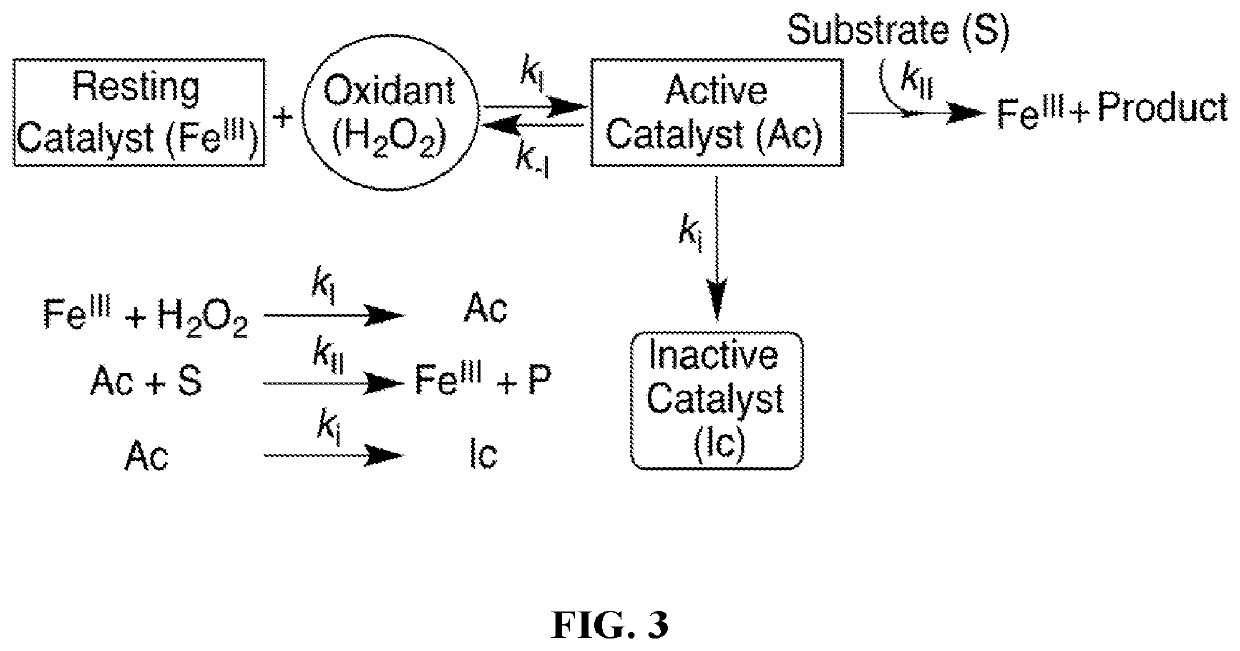Far superior oxidation catalysts based on macrocyclic compounds
a macrocyclic compound and oxidation catalyst technology, applied in the field of metal chelate complexes, can solve the problems of rationalizing the stability wall and unable to find iterative design steps that could break through, and achieve the effect of efficient oxidative catalysis, high donation, and convenient access to reactive high valent states
- Summary
- Abstract
- Description
- Claims
- Application Information
AI Technical Summary
Benefits of technology
Problems solved by technology
Method used
Image
Examples
example 1
[0153]A. 1,2-Diamino-4,5-Dimethoxy Benzene from 1,2-Dimethoxy Benzene (veratrole) 1,2-Dinitro-4,5-Dimethoxy Benzene: Veratrole was doubly nitrated according to the procedure of Drake et al, in “Synthetic Antimalarials. Some Derivatives of 8-Aminoquinoline”, J. Amer. Chem. Soc., 1536, Vol. 68 (1946). Nitric acid (68.3 g, conc.) was added (dropwise, 1 h) to a well stirred solution of veratrole (48.3 g, 350 mmol, d=1.084) in glacial acetic acid (1450 mL) initially cooled to 15° C. The mixture needs to be held below 40° C. but above 10° C. by cooling and proper regulation of the rate of addition of the acid. Considerable mononitroveratrole separated out. Stirring was continued and additional nitric acid (212.7 mL, fuming) was added (dropwise, 1 h) while the temperature of the solution was held below 30° C. As the second nitration proceeded the mono nitroveratrole dissolved and when all the acid had been added, the solution was clear. The nitration mixture was allowed to stand for two ho...
example 2
Macro Linker Intermediate (A-B-A) Synthesis, from 2-Aminoisobutyric Acid and o-Phenylenediamine
[0157]i. Synthesis of 2-Methyl-2-phthalimidopropanoic acid
2-aminoisobutyric acid (25 g, 0.24 mol, 1 eq) and phthalic anhydride (58 g, 0.39 mol, 1.6 eq) were melted in a 500 ml round bottomed flask at 190° C. The compounds were mixed thoroughly with a glass rod before melting. The melt gradually turned clear with bubbles of water (side product). The reaction was assumed complete when the water bubbles ceased to form. The reaction was continued at the same temperature for 20 min longer then poured slowly into a saturated sodium bicarbonate solution (˜1.5 L). The solution was filtered through a glass frit containing celite. The filtrate was cooled in an ice bath and acidified to pH 2 with concentrated HCl. The product precipitated and was isolated by filtration of the solution through a glass frit and dried under vacuum at 60° C. overnight. Yield: 83%; 1H NMR (d6-DMSO) 12.92 (s, 1 H), 7.85 (s...
example 3
Macro Linker Intermediate (B-L-B) Synthesis, from methanesulfonic acid dichloride and o-Phenylenediamine
[0158]i. Synthesis of tert-butyl (2-aminophenyl)carbamate
Recrystallized o-phenylenediamine (3.0 g, 27.8 mmol) and triethylamine (3.8 mL, 27.8 mmol) were dissolved in 50 mL dry THF in a round bottom flask. In a second flask, di-tert-butyl-dicarbonate (6.0 g, 27.8 mmol) was dissolved in 50 mL dry THF. The solutions were added dropwise simultaneously with a syringe pump to a third flask containing 60 mL dry THF at 0° C. and allowed to warm to room temperature and stir overnight. The solvent was removed from the clear solution under reduced pressure to give a brown oil. Diethyl ether (25 mL) was added to the oil and sonicated until homogeneous. The diethyl ether was removed under reduced pressure to give a brownish-pink solid. Recrystallization in hot heptane / ethanol yielded off-white flaky crystals. 1H NMR (300 MHz, CDCl3): 7.30 (1H, m), 7.02 (1H, m), 6.80 (2H, m), 6.24 (br s, 1H), 3...
PUM
| Property | Measurement | Unit |
|---|---|---|
| temperature | aaaaa | aaaaa |
| volume | aaaaa | aaaaa |
| yield | aaaaa | aaaaa |
Abstract
Description
Claims
Application Information
 Login to View More
Login to View More - R&D
- Intellectual Property
- Life Sciences
- Materials
- Tech Scout
- Unparalleled Data Quality
- Higher Quality Content
- 60% Fewer Hallucinations
Browse by: Latest US Patents, China's latest patents, Technical Efficacy Thesaurus, Application Domain, Technology Topic, Popular Technical Reports.
© 2025 PatSnap. All rights reserved.Legal|Privacy policy|Modern Slavery Act Transparency Statement|Sitemap|About US| Contact US: help@patsnap.com



